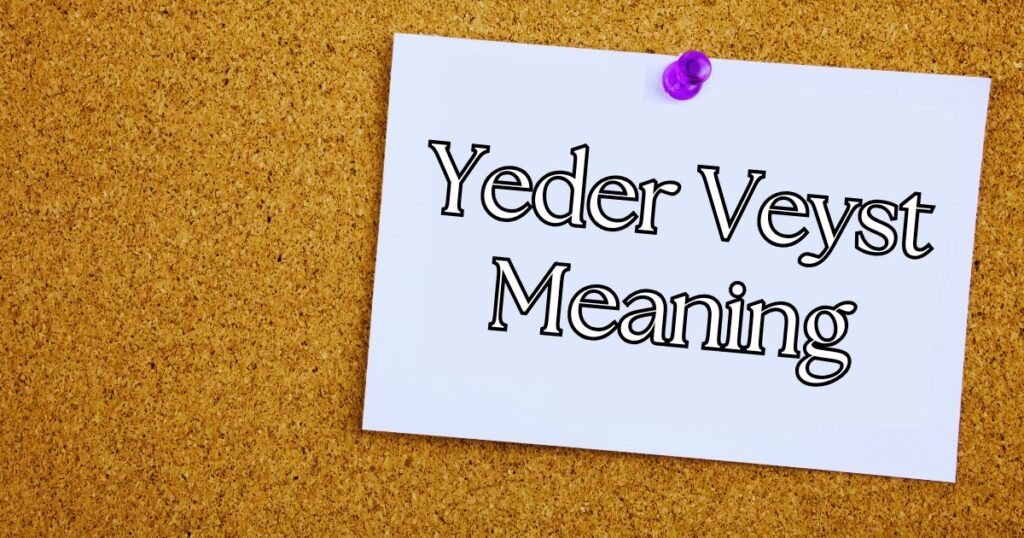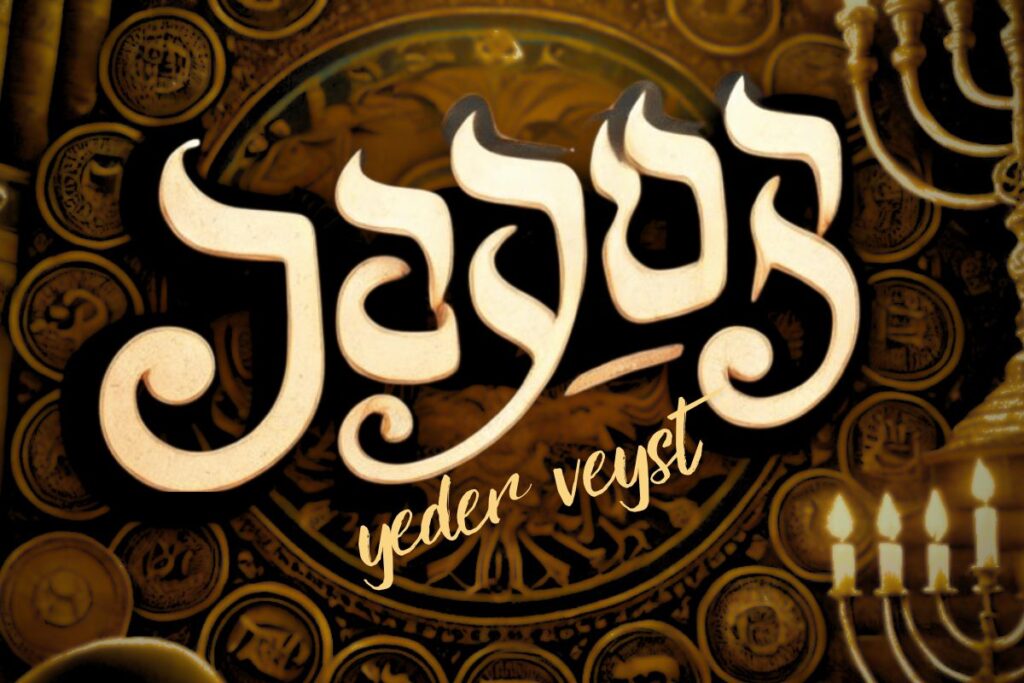Yeder Veyst Meaning in English: A Guide to Its Culture and History
The phrase “Yeder Veyst” meaning in English is “everyone knows.” This simple expression from the Yiddish language holds deep cultural and historical importance. While it may seem straightforward, its roots in Jewish life and community reveal layers of shared knowledge and tradition. Understanding its meaning connects us to a rich history of language and culture.
“Yeder Veyst” meaning in English is more than just words; it’s a window into the world of Yiddish-speaking communities. For centuries, this phrase captured ideas that everyone in a group understands without explanation. Today, it’s a powerful reminder of how language keeps traditions and connections alive, even in modern times.
What Does “Yeder Veyst” Mean in English? Exploring the Basics
Yeder Veyst is a phrase from the Yiddish language that translates to “everyone knows” or “everybody knows.” It is commonly used to express something that is universally understood within a community. The phrase has deep roots in Jewish culture, especially in Eastern European communities where Yiddish was spoken widely.
In everyday conversations, “Yeder Veyst” is used to highlight common knowledge. When someone says this, they’re suggesting that the information or idea being discussed is so well-known that it doesn’t need an explanation. This reflects the strong sense of shared understanding that exists in close-knit communities.
Yiddish has always been more than just a language; it’s a part of Jewish history. Phrases like “Yeder Veyst” carry weight because they connect people to a long-standing tradition and collective memory. The expression shows how certain things, such as cultural norms or shared experiences, don’t need to be explained—they are simply understood by all.
Why “Yeder Veyst” Is More Than Just Common Knowledge

“Yeder Veyst” means more than just something everyone knows; it speaks to a shared sense of community. In Jewish culture, common knowledge often includes deeper values, customs, and ways of thinking that bond people together. It’s not just about facts but about mutual understanding and trust within the community.
Common knowledge in this sense often reflects the community’s shared experiences. When “Yeder Veyst” is used, it’s not only pointing out that everyone knows a fact, but also implying that everyone has had the same experiences or teachings to reach that knowledge. This collective understanding is what makes the phrase so powerful in Jewish communities.
- It’s often used to emphasize cultural wisdom.
- The phrase can also be found in Jewish stories and folklore.
- It can be used humorously or ironically, adding extra layers to conversations.
The power of this expression lies in its ability to unite people through shared knowledge. Over time, it has become a symbol of the closeness and interconnectedness of Jewish communities, especially in pre-war Europe.
The Roots of Yiddish: Where Did “Yeder Veyst” Come From?

The expression “Yeder Veyst” comes from the Yiddish language, which created among Ashkenazi Jews in Focal and Eastern Europe. Yiddish is a mix of German, Hebrew, Aramaic, and Slavic dialects, and it turned into the essential language for a large number of Jews.
Yiddish is a language that reflects Jewish life, culture, and religion. Phrases like “Yeder Veyst” grew out of this language because they expressed everyday realities and experiences that Jews shared in their communities. In Jewish folklore, such expressions carry deep meanings and often reflect the community’s values.
In the past, Yeder Veyst was more than just a saying—it was a way of life. The phrase was commonly used in villages, markets, and synagogues where everyone knew each other. It helped bind communities together, reinforcing the sense that certain things were simply understood.
Cultural Importance: How “Yeder Veyst” Reflects Jewish Life
“Yeder Veyst” is an expression that reflects significantly more than information — it addresses an aggregate character Yiddish, as a language, was used to express the unique experiences of Jewish communities, especially those in Eastern Europe. Communities speaking Yiddish were tightly knit, and shared wisdom was central to daily life.
The phrase “Yeder Veyst” also reflects the importance of shared history. In Jewish tradition, understanding and passing down knowledge from one generation to the next is key. This is why phrases like this are so important—they encapsulate generations of lived experiences and collective memory.
Yeder Veyst connects people not just by facts, but by understanding the cultural context in which those facts were learned. The phrase can be used to emphasize a shared cultural memory or the fact that certain knowledge transcends generations.
- It’s a tool for creating community bonds.
- It helps remind people of shared cultural values and norms.
- The phrase conveys respect for cultural history.
“Yeder Veyst” in Eastern Europe: A Shared Language of Community
Before World War II, Yiddish was the language of millions of Jews in Eastern Europe. It was spoken by people from all walks of life, from scholars to laborers, and in all settings—from the synagogue to the market. The phrase “Yeder Veyst” was commonly heard in everyday conversation, reflecting the communal nature of life at the time.
This shared language helped build a strong sense of community. “Yeder Veyst” was used to communicate ideas that were understood by everyone, creating a sense of belonging and solidarity among Jewish people. The phrase reflected a deep understanding of local customs and traditions.
- Yiddish was a unifying language for Eastern European Jews.
- “Yeder Veyst” helped people feel connected and understood.
- It highlighted the importance of communal wisdom.
Through phrases like “Yeder Veyst,” Jewish communities across Eastern Europe maintained a strong bond of shared knowledge. This language helped preserve their traditions and culture during times of hardship.
The Revival of Yiddish: How “Yeder Veyst” Lives On
Despite the decline of Yiddish after the Holocaust, the language is seeing a revival today. Phrases like “Yeder Veyst” are being rediscovered and celebrated by younger generations who wish to reconnect with their Jewish heritage.
In modern times, Yiddish has found a place in cultural festivals, theaters, and online communities. The revival of Yiddish language classes and cultural events is helping to keep traditions alive. Young Jews are embracing the language, and phrases like “Yeder Veyst” are finding new life.
Key Factors in Yiddish’s Revival:
- Cultural Festivals: These events celebrate Yiddish language and culture.
- Language Courses: Classes are being offered to teach Yiddish to new generations.
- Online Communities: Social media platforms are promoting Yiddish learning and discussions.
As Yeder Veyst is rediscovered, it serves as a link to Jewish history and identity, making it an essential part of cultural heritage. The phrase, though simple, holds great significance in a world where understanding and preserving traditions is more important than ever.
Conclusion: The Importance of “Yeder Veyst” in Jewish Culture
“Yeder Veyst” is something other than an expression — it’s a window into Jewish culture and history. This expression shows how much value is placed on shared knowledge within the community. It helps people feel connected, reminding them of their common experiences and traditions. The phrase continues to be an important part of Jewish life, even as it is rediscovered by newer generations.
As we learn more about “Yeder Veyst”, we realize how language can shape the way we understand the world around us. This simple phrase carries a lot of meaning, showing the power of shared knowledge in bringing people together. Whether in old communities or new, “Yeder Veyst” reminds us that some things don’t need explaining because they are already understood by all.






Post Comment